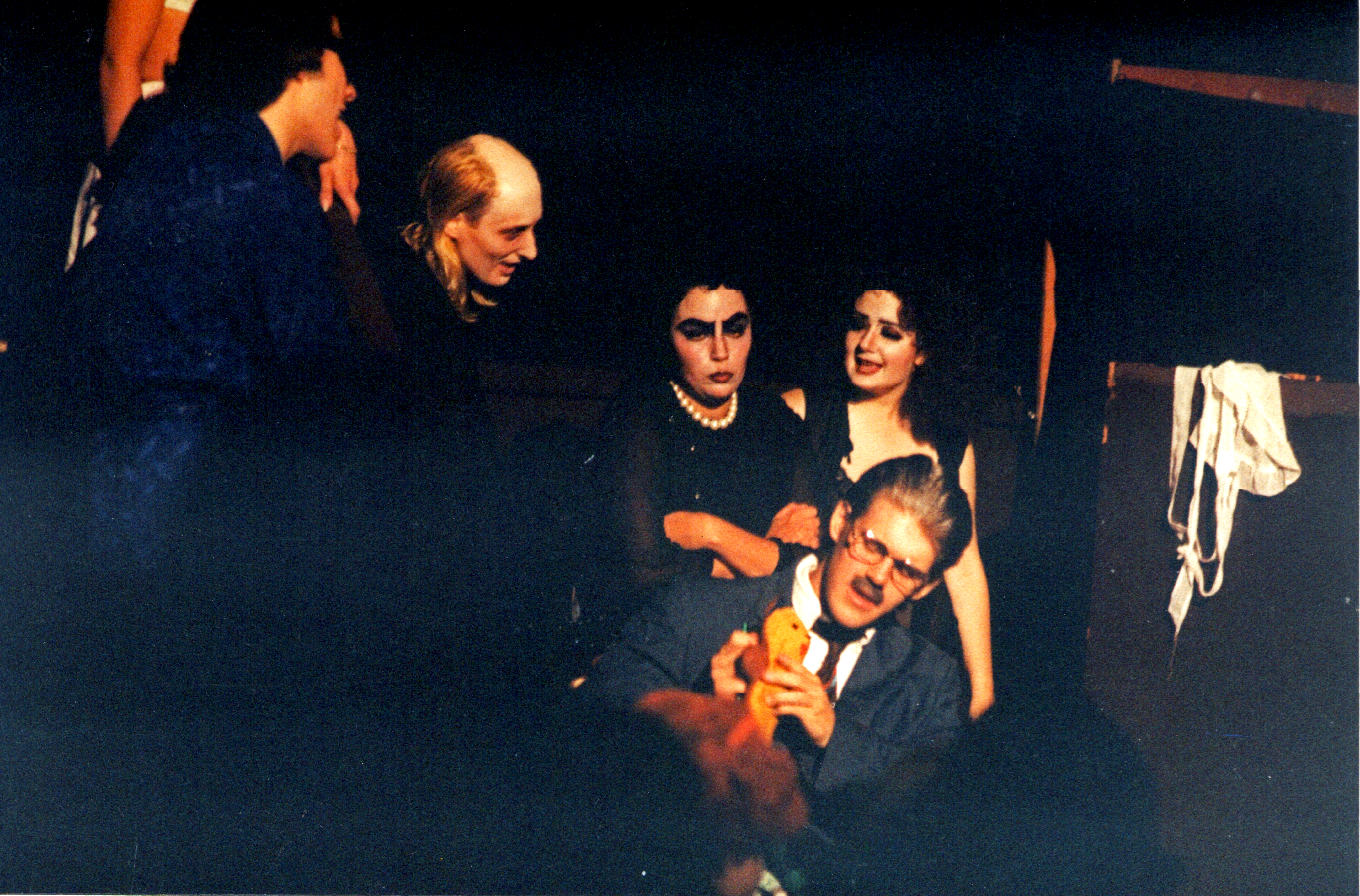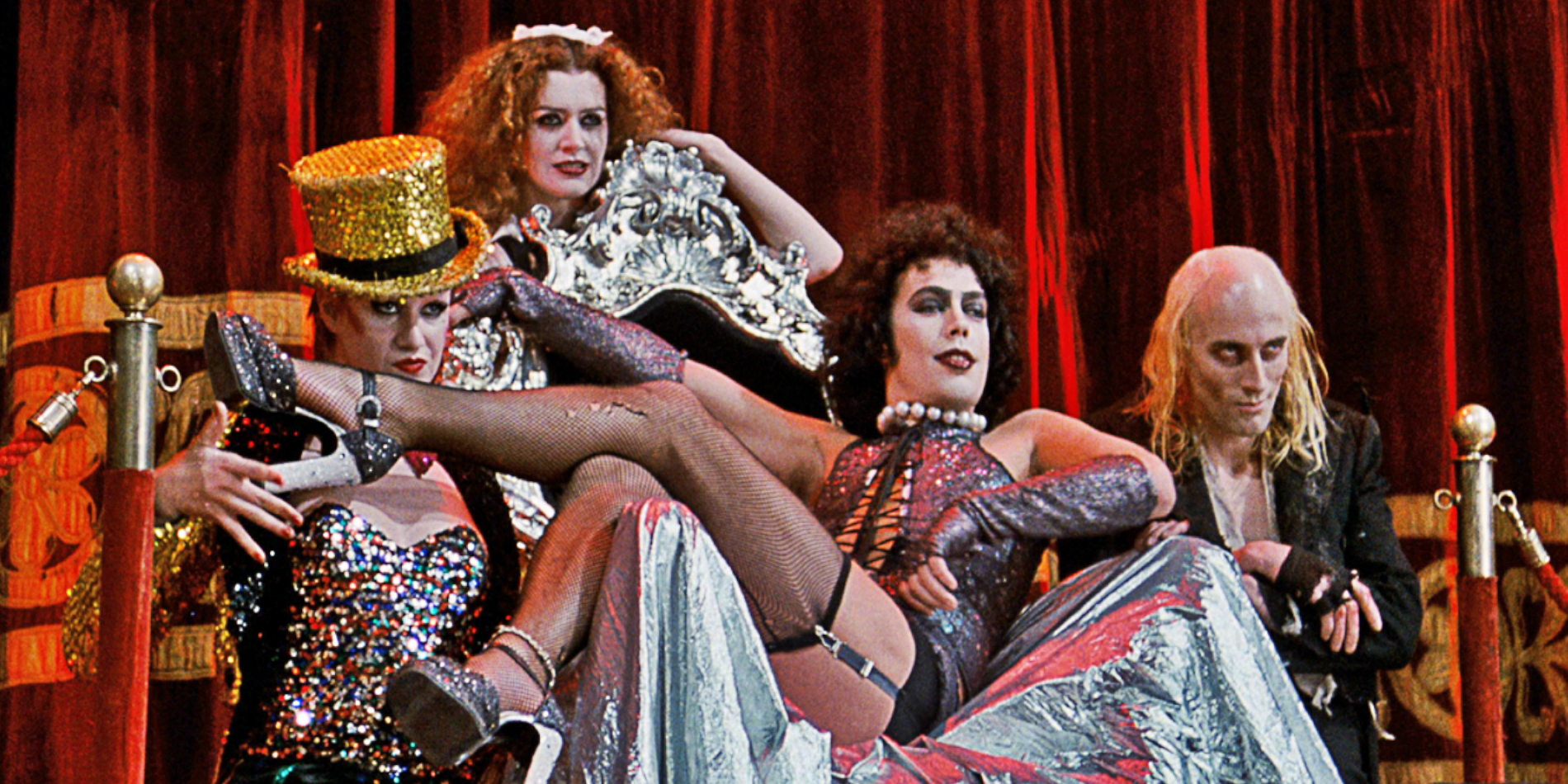The Rocky Horror Picture Show is one of my favorite movies. It is a film I go back and rewatch every few months. However, one of my favorite ways to experience the movie is in a cinema with a shadow cast. It is truly a joyous experience that very few things can match.
But the Rocky Horror movie theater experience can also teach you a lot about GM’ing and designing games, as the two things have more in common than you may think. In fact, I would suggest that all game designers and GMs check it out at least once.
Let’s Do The Time Warp Again: What Is A Shadow Cast?
Usually, I start posts like this with a brief summary of the media I’m talking about. The date it was released, the general storyline, its historical context, and stuff like that.
But honestly, if you’ve never seen The Rocky Horror Picture Show, you really should. Seriously save this post and go watch the movie. You won’t regret it. I’ll be here when you’re done.
Okay, got Time Warp stuck in your head? Good!
Now, while watching Rocky Horror at home is fun, watching it in a movie theater is incredible. Many theaters offer the movie with a Shadow Cast. A shadow cast is a collection of local performers who act out parts of the movie while it’s playing on the screen. Basically, lip-synching along with the film.
On top of this, Rocky Horror is famous for its audience participation. At many showings, the audience brings props. And these props are used during specific parts of the movie. For instance, when Frank N. Furter puts on a party hat during one scene, the audience will put on their own party hats.
In the middle of a song titled “I’m Going Home,” a character sings the line “Cards for sorrow, cards for pain,” and the audience responds by throwing cards into the air.
Plus, there is also a load of “callbacks” the fan community uses. These are things the audience shouts during the movie. Sometimes they’re an echo of a line said by a character. Sometimes, they’re a response said to an on-screen event, or sometimes they’re shouted before a line in the movie to turn the line into a dirty joke.
For instance:
Riff Raff: You’ve arrived on a rather special night. It’s one of the master’s affairs.
Audience: Which one?
Riff Raff [Being whipped]: Owwwwwwwwwwwwwwwww!
Audience: Say thank you in French!
Riff Raff: Mercy!
Rocky: I’m just seven hours old
Audience: And can’t dance!
Rocky: And truly beautiful to behold.
Audience: And modest, too!
Super Heroes: How Are TTRPGs and Shadow Casts Linked?

The Shadow Cast Rocky Horror experience is something every GM or game designer should experience as, in many ways, the Rocky Horror experience mirrors the TTRPG experience.
At their core, they are both examples of shared storytelling and improv. Both give participants a structure and framework to work within. This is the game system in the case of TTRPGs. And the movie itself for Rocky Horror.
But the people involved can add different things to this formula to create a unique experience. TTRPG sessions are shaped by the choices the players make and what roleplay they engage in. However, at Rocky Horror, different audiences shape their experience by what audience participation they use.
While Rocky Horror has some famous audience interactions and callbacks, you’ll find that the experience varies heavily depending on the theater you’re in. In fact, each audience will get a different experience as those viewing the movie are encouraged to add their own jokes and quips and each area and cast has its own unique gags.
The best example is at the start of “Time Warp.” When Riff Raff reveals a skeleton, it is common for audiences to shout out the name of a recently deceased celebrity. But there are loads of others. For instance, it is common to shout that Rocky got his degree from the local university whenever he does something silly.
Even individual friend groups will have their own little jokes. For instance, if you watch the film with me, you’ll likely hear me say “Action Loaf” during the scene where Eddie is driving his motorcycle around the lab. This is a reference to the RiffTrax dub of To Catch a Yeti, another movie featuring Eddie’s actor.
And these little local flourishes and random moments make the experience super memorable and keep the experience fresh even when you’ve participated in it several times before.
Rose Tint My World: What GMs Can Learn From A Shadow Cast

One of the biggest things GMs and game designers should take away from the shadow cast experience is how they create an environment that encourages audience participation. While leaving it accessible to newbies.
1. Ground Rules
Setting ground rules is extremely important. Most shadow cast performances start with a rundown of the theater’s rules. These cover everything from practical stuff (e.g., where fire escapes are) to content warnings (e.g., what jokes are okay). These rules mean that everyone knows what is acceptable from the start, and the best shadow casts make these rules exceptionally clear, so there are no grey areas.
As a TTRPG GM, you should be doing the same. Making clear and firm ground rules that everyone can understand and follow allows everyone to feel safe and have a good time. And it makes sure everyone knows what is expected of them.
2. Onboarding Newbies And Icebreaking
Good shadow casts work hard to make the experience accessible to newbies, especially those who have not seen the film before. Most theaters that supply props will include a list telling you when to use them. Plus, most shadow casts will have one or two performers in the audience. The performers use the props and shout the most famous callbacks to help guide the audience through the experience.
This is great on two levels. Firstly, it helps newbies learn what to do without needing to ask someone. They can look at the list and copy the performers in the audience. So, they still get a complete experience, even if they come in with zero foreknowledge.
Secondly, these performers act as fantastic icebreakers. No one wants to be the first to shout something for fear of being laughed at or overstepping a boundary. The performers being there helps break the ice, giving people the confidence to get involved and participate. Plus, they help the audience understand the rules and boundaries of the show. Acting as visible examples of how to take part while obeying the rules.
When designing a game, thinking about onboarding is vitally important. So, think about what tools you’re giving to GMs and players to help them learn about and ease themselves into the experience.
The icebreaker element is something all GMs should keep in mind. Players will use your behavior to work out what is expected of them. Your behavior will also help them understand how the ground rules work during play. If you break your own ground rules, you erode player trust and leave them unsure of how they should act at the table. Leading to players feeling confused and unsafe. And this may lead to players deciding to leave the group and the hobby as a whole.
While it is a cliche, “treat others as you want to be treated” is a good rule of thumb to keep in mind whenever you run a game, especially if you’re running it for people who don’t know you well.
This also applies to general gameplay and roleplay. If you want your players to do something, be sure that you are doing it yourself, especially in the early sessions. It helps set boundaries and it removes the social awkwardness of being the first to do something. So, if you want your players to use character voices, give your NPCs unique voices. Similarly, if you want your players to be dramatic, you should act dramatically.
And don’t think you need to be good. In fact, doing it badly is often better! Because it shows your players that perfection isn’t required. It shows them they can have a go at something without fear of being mocked or laughed at and removes the innate fear of being “the worst” in the group.
3. Give People Space
Rocky Horror’s audience participation wasn’t something the production company came up with as a bit of viral marketing. The audience participation was created by fans of the film.
It didn’t come into the world fully-formed, either. Instead, the audience participation grew over time, with new bits getting added until it became what it is today. In many ways, Rocky Horror audience participation is an oral tradition passed from person to person.
But, as previously mentioned, each area will feature several local jokes. And every shadow cast has its own little jokes or references they’ll include in the show, and several different audience participation scripts exist, each with slightly different gags.
And even today, showings of Rocky Horror will often feature the audience coming up with new quips. Sure, some will flop, but some may become popular and enter that local group’s lexicon.
And this is only possible because viewers and participants are given space to have fun. Space to improvise. Every commonly accepted callback was once a random gag shouted out by an audience member, and they could only do that because they were given a space in which they could freely improvise.
And a TTRPG table is the same. The best moments often come out of the most unexpected scenes. So, if you’re a GM, give your players space to come up with stuff and explore. Allow things to go off on random tangents sometimes. Because those tangents can often create lasting memories.
Jonathon Greenall is a freelance writer, artist, and tabletop roleplaying game designer who has written for CBR, Polygon, Nintendo Life, Gayley Dreadful, Enbylife, and many other publications. They have also published several popular and highly-praised tabletop roleplaying games including “You Have One Ability….The Ability To Fuck This Up,” “Macarons, Milkshakes, And Magic,” and “Wander Wizards.”
Jonathon has always been fascinated by media, from the big hitters to the small, obscure, and often overlooked titles that linger on the sidelines, capturing both the on and off-camera stories that make these shows so fascinating.
Jonathon is also a major anime fan, having been exposed to the medium through shows like Sailor Moon and Revolutionary Girl Utena. Since then, Jonathon has maintained a passion for anime, watching most new shows each season and hunting down overlooked gems from previous ones.

